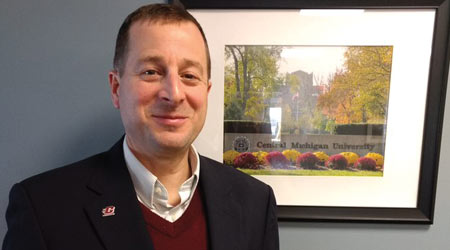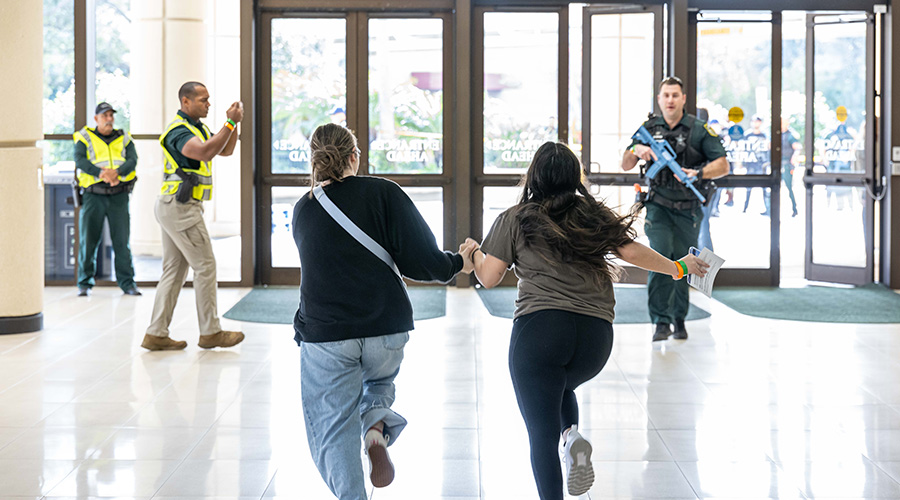 Jonathan Webb, Associate Vice President of Facilities Management, Central Michigan University
Jonathan Webb, Associate Vice President of Facilities Management, Central Michigan UniversityFlooding on Campus Leads to Lessons in Emergency Preparedness
Planning and experience prepared Jonathan Webb for the challenges of 2017 floods at Central Michigan University
By Ryan Berlin, Managing Editor
OTHER PARTS OF THIS ARTICLEPt. 1: This Page
When a crisis strikes, maintenance and engineering managers need to have plan in place in order to properly and effectively deal with the situation. In June 2017, Central Michigan University in Mt. Pleasant, Mich. faced an unprecedented natural disaster.
Flooding caused more than $100 million in property damage in the surrounding community and affected 60 of 127 facilities on campus. In the ensuing days and weeks, Jonathan Webb, the university’s associate vice president of facilities management, had emergency response plans in place to help control the situation and deal with stormwater mitigation.
How did you begin your career in facilities management?
Growing up, my dad had his own land surveying business. I was always out in the field or in the office with my father. Construction sites were a familiar sight. So when I went to college, I pursued a degree in civil engineering. After college, I was a civil engineer officer in the Air Force starting in 1990 and served 25 years on active duty. My responsibilities in the Air Force were equivalent to what I do here at Central Michigan University. At facilities management here, we have operations and maintenance, energy and utilities, landscape operations, and an engineering section that oversees planning, design, and construction.
What designations have you earned?
I received an engineering training certificate from the state of California in 1991. I then focused on education as it related to my military career. I have master’s degrees in management from Webster University, military operational arts and science from the Air Force Command and Staff College. Then I attended the U.S. Naval War College, receiving a master’s degree in national security and strategic studies.
What are the most rewarding and challenging parts of your job?
The most rewarding is the day-to-day operations — being able to walk around as part of my job and seeing what’s going on around campus. I enjoy meeting and talking with our team members — our skilled trades, custodians, project managers, and students.
Every day comes with small challenges. We look for areas to make improvements, and when we have challenges, we work through them. That is facilities management. There is always something going on, and the rewarding part is how to best approach each challenge and resolve issues.
What is the best piece of career advice you have received?
The best facilities management advice I have received is to have a solid understanding of the funds and people in the organization. These are the two key resources that allow for facilities management to function, and I have carried this advice through my entire career.
What accomplishment are most proud of at Central Michigan University?
I am most proud of helping build teams, strengthen partnerships, increase communication and improve customer service. That is the most important thing we can do from a day-to-day standpoint. We have a great facilities management team here.
When I arrived, we completed a $95 million bioscience building, and I’m proud of the team for this accomplishment. We are in the process of putting up a $26 million center for integrated health studies, and we have multiple other projects waiting to get started. The improvements here at Central are continuous. That is one of the things I like about being here, as there is clear vision about where we want to be, and the facilities and campus are a big part of that vision.
Describe the emergency you and your team faced.
We received a 200-year storm in the Mt. Pleasant area in June 2017 that directly impacted campus and the surrounding communities. It was an extremely high-intensity rain in a very short period. It was proceeded by several weeks of rain, so we already had saturated ground. The storm caused serious flooding. We had 60 facilities that were impacted of the 127 we have on campus. It was a significant event.
There was a lot of basement flooding. We also had plenty of roof leaks, as downspouts were not able to transfer water off the roofs because the storm sewer systems were completely full. Utility systems were also impacted. Our Student Activities Center received the most damage, with 44,000 square-feet hardwood floor being damaged. Additionally, one of our research facilities had significant flooding, which impacted lab equipment. Hence, it wasn’t just the facilities that were affected by the storm.
What efforts did the university take to recover from this flood.
We were fortunate the storm hit the between the first and second summer terms. So the decision to close campus that day was an easy one. It was all hands on deck for the facilities management and residence life teams that take care of the residence halls. Initially, we were conducting damage assessment and mitigating emergencies as it related to electrical and underground utility systems. From there, it was continued damage assessment as we inspected every facility on campus.
Additionally, local contractors were able to mobilize quickly to assist CMU just a few hours after the storm passed through. We had flatbed-mounted pumps and other equipment that the contractors were able to mobilize from other parts of the state. We also have a very experienced skill trade workforce. With their knowledge and experience of the facilities and utility systems on campus, we were quick to respond and resolve the most critical issues.
How has this flood changed the way you prepare for a weather emergency?
We have been reviewing all of our emergency management procedures and documents since the flood. We have reinvigorated our emergency management program, and we have updated our emergency management website for better education and preparedness for all those who come to Central Michigan University. We are in the process of updating our hazard vulnerability assessment, hazard mitigation plan, and emergency operations plans. This is all part of the emergency preparedness cycle and the commitment of the university to follow the national incident management system.
How did the university’s operations and activities affect the planning and performance of the response?
We were in between two summer sessions when the flooding occurred, so it was pretty quiet on campus. Some of our classrooms were impacted, so our registrar had to move classes around while crews cleaned and restored these areas. Again, the timing of the flood event was very fortuitous. It gave us Saturday and Sunday to stabilize the campus and Summer 2 classes started as scheduled. Of course, we did have to adapt because there were areas of campus we had to close.
What challenges did you face during the flood response?
Establishing proper management controls was a critical business process. We adapted to meet the very fast pace of work in responding to the flood. While the more public focus was on identifying requirements and rapidly mobilizing in-house and contractor teams, we also developed a flood-support administrative support team to ensure proper accounting, control and documentation of all activities.
We were fortunate that our insurance company sent adjustors to campus within three days of the flood. We conducted damage assessments concurrently, which was a huge help.
Related Topics:












